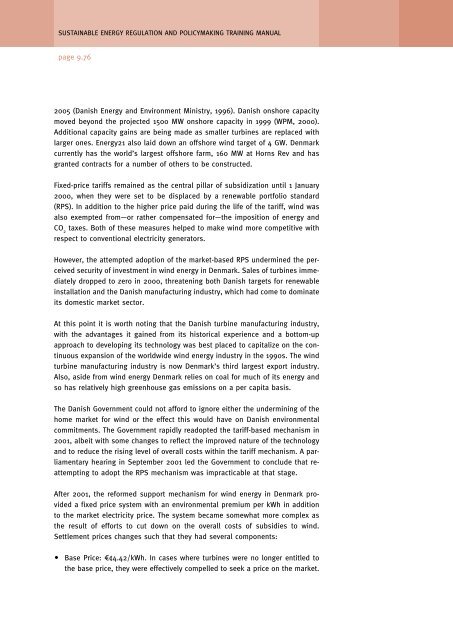Regulatory and policy options to encourage development of ...
Regulatory and policy options to encourage development of ...
Regulatory and policy options to encourage development of ...
- No tags were found...
You also want an ePaper? Increase the reach of your titles
YUMPU automatically turns print PDFs into web optimized ePapers that Google loves.
SUSTAINABLE ENERGY REGULATION AND POLICYMAKING TRAINING MANUALpage 9.762005 (Danish Energy <strong>and</strong> Environment Ministry, 1996). Danish onshore capacitymoved beyond the projected 1500 MW onshore capacity in 1999 (WPM, 2000).Additional capacity gains are being made as smaller turbines are replaced withlarger ones. Energy21 also laid down an <strong>of</strong>fshore wind target <strong>of</strong> 4 GW. Denmarkcurrently has the world’s largest <strong>of</strong>fshore farm, 160 MW at Horns Rev <strong>and</strong> hasgranted contracts for a number <strong>of</strong> others <strong>to</strong> be constructed.Fixed-price tariffs remained as the central pillar <strong>of</strong> subsidization until 1 January2000, when they were set <strong>to</strong> be displaced by a renewable portfolio st<strong>and</strong>ard(RPS). In addition <strong>to</strong> the higher price paid during the life <strong>of</strong> the tariff, wind wasalso exempted from—or rather compensated for—the imposition <strong>of</strong> energy <strong>and</strong>CO 2taxes. Both <strong>of</strong> these measures helped <strong>to</strong> make wind more competitive withrespect <strong>to</strong> conventional electricity genera<strong>to</strong>rs.However, the attempted adoption <strong>of</strong> the market-based RPS undermined the perceivedsecurity <strong>of</strong> investment in wind energy in Denmark. Sales <strong>of</strong> turbines immediatelydropped <strong>to</strong> zero in 2000, threatening both Danish targets for renewableinstallation <strong>and</strong> the Danish manufacturing industry, which had come <strong>to</strong> dominateits domestic market sec<strong>to</strong>r.At this point it is worth noting that the Danish turbine manufacturing industry,with the advantages it gained from its his<strong>to</strong>rical experience <strong>and</strong> a bot<strong>to</strong>m-upapproach <strong>to</strong> developing its technology was best placed <strong>to</strong> capitalize on the continuousexpansion <strong>of</strong> the worldwide wind energy industry in the 1990s. The windturbine manufacturing industry is now Denmark’s third largest export industry.Also, aside from wind energy Denmark relies on coal for much <strong>of</strong> its energy <strong>and</strong>so has relatively high greenhouse gas emissions on a per capita basis.The Danish Government could not afford <strong>to</strong> ignore either the undermining <strong>of</strong> thehome market for wind or the effect this would have on Danish environmentalcommitments. The Government rapidly readopted the tariff-based mechanism in2001, albeit with some changes <strong>to</strong> reflect the improved nature <strong>of</strong> the technology<strong>and</strong> <strong>to</strong> reduce the rising level <strong>of</strong> overall costs within the tariff mechanism. A parliamentaryhearing in September 2001 led the Government <strong>to</strong> conclude that reattempting<strong>to</strong> adopt the RPS mechanism was impracticable at that stage.After 2001, the reformed support mechanism for wind energy in Denmark provideda fixed price system with an environmental premium per kWh in addition<strong>to</strong> the market electricity price. The system became somewhat more complex asthe result <strong>of</strong> efforts <strong>to</strong> cut down on the overall costs <strong>of</strong> subsidies <strong>to</strong> wind.Settlement prices changes such that they had several components: Base Price: €¢4.42/kWh. In cases where turbines were no longer entitled <strong>to</strong>the base price, they were effectively compelled <strong>to</strong> seek a price on the market.










